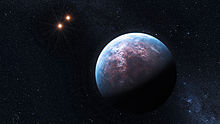astro.wikisort.org - Meteorite
Gliese 667 Cb is an exoplanet orbiting the star Gliese 667 C, a member of the Gliese 667 triple-star system. It is the most massive planet discovered in the system and is likely a super-Earth or a mini-Neptune. Orbital-stability analysis indicates that it cannot be more than twice its minimum mass. It orbits too close to the star to be in the habitable zone and thus not suitable for life as we know it.[1] Eccentricity analysis indicates that Gliese 667 Cb is not a rocky planet.[2]
 Artist's impression of Gliese 667 Cb if rocky with the Gliese 667 AB binary in the background | |
| Discovery | |
|---|---|
| Discovery date | 2009 |
Detection method | Radial velocity (European Southern Observatory) |
| Orbital characteristics | |
Semi-major axis | 0.050432±0.000001 AU |
| Eccentricity | 0.112 |
Orbital period (sidereal) | 7.2006 d |
| Inclination | >30 |
| Semi-amplitude | 3.8 |
| Star | Gliese 667C |
| Physical characteristics | |
| Mass | 5.94–~12 MEarth |
| Temperature | 473 K (200 °C; 392 °F) |
The planet is likely to be tidally locked. Thus, one side of the planet is in permanent daylight and the other side in permanent darkness.[3]
References
- Anglada-Escudé, Guillem; et al. (7 June 2013). "A dynamically-packed planetary system around GJ 667C with three super-Earths in its habitable zone" (PDF). Astronomy & Astrophysics. 556: A126. arXiv:1306.6074. Bibcode:2013A&A...556A.126A. doi:10.1051/0004-6361/201321331. Archived from the original (PDF) on 30 June 2013. Retrieved 25 June 2013.
- "The high multiplicity systems Gliese 667C and KOI 3158". Second Kepler Science Conference. 5 November 2013. Retrieved 27 February 2018.
- Potentially Habitable Planets of Star Gliese 667C Explained (Infographic) - Space.com
На других языках
- [en] Gliese 667 Cb
[es] Gliese 667 Cb
Gliese 667 Cb es un planeta extrasolar que orbita la estrella de tipo M de la secuencia principal Gliese 667 C, localizado aproximadamente a 23 años luz en la constelación de Scorpius. Este planeta tiene una masa 5,7 veces la de la Tierra (clasificándose como una supertierra y tarda una semana en completar su periodo orbital, siendo su semieje mayor de aproximadamente 0,05 UA. Sin embargo, a diferencia de la mayoría de los exoplanetas conocidos, su excentricidad no se conoce, pero es habitual que se desconozca su inclinación. Este planeta fue detectado por HARPS el 19 de octubre de 2009, junto con 29 otros planetas.[ru] Глизе 667 C b
Глизе 667 C b — экзопланета вне обитаемой зоны, первая экзопланета у звезды Глизе 667 C в тройной системе Глизе 667. Планета удалена от Земли на ~ 22,7 световых лет.[2][5][3]Текст в блоке "Читать" взят с сайта "Википедия" и доступен по лицензии Creative Commons Attribution-ShareAlike; в отдельных случаях могут действовать дополнительные условия.
Другой контент может иметь иную лицензию. Перед использованием материалов сайта WikiSort.org внимательно изучите правила лицензирования конкретных элементов наполнения сайта.
Другой контент может иметь иную лицензию. Перед использованием материалов сайта WikiSort.org внимательно изучите правила лицензирования конкретных элементов наполнения сайта.
2019-2025
WikiSort.org - проект по пересортировке и дополнению контента Википедии
WikiSort.org - проект по пересортировке и дополнению контента Википедии

